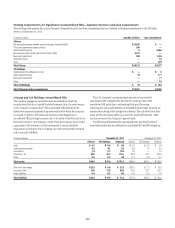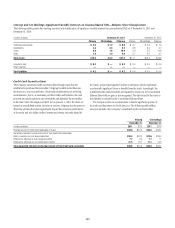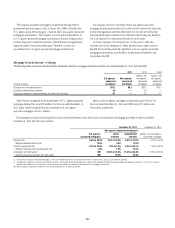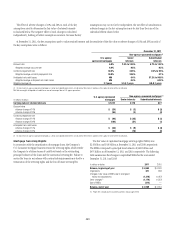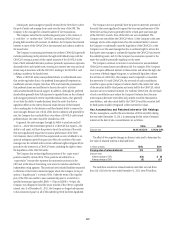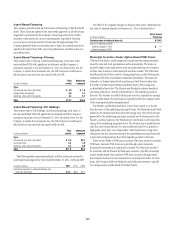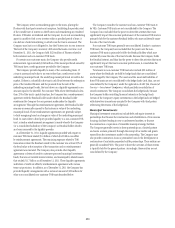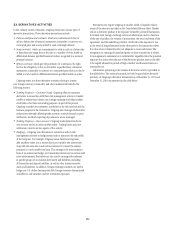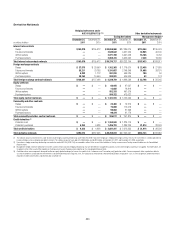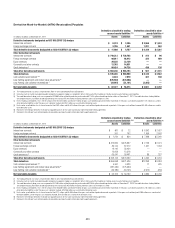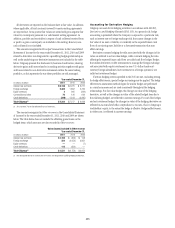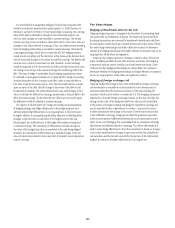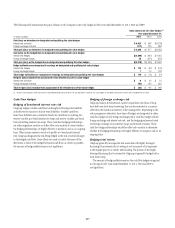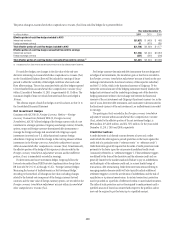Citibank 2011 Annual Report Download - page 251
Download and view the complete annual report
Please find page 251 of the 2011 Citibank annual report below. You can navigate through the pages in the report by either clicking on the pages listed below, or by using the keyword search tool below to find specific information within the annual report.
229
Asset-Based Financing
The Company provides loans and other forms of financing to VIEs that hold
assets. Those loans are subject to the same credit approvals as all other loans
originated or purchased by the Company. Financings in the form of debt
securities or derivatives are, in most circumstances, reported in Trading
account assets and accounted for at fair value through earnings. The
Company generally does not have the power to direct the activities that most
significantly impact these VIEs’ economic performance and thus it does not
consolidate them.
Asset-Based Financing—Citicorp
The primary types of Citicorp’s asset-based financings, total assets of the
unconsolidated VIEs with significant involvement and the Company’s
maximum exposure to loss at December 31, 2011 are shown below. For the
Company to realize that maximum loss, the VIE (borrower) would have to
default with no recovery from the assets held by the VIE.
In billions of dollars
Total
assets
Maximum
exposure
Type
#OMMERCIALæANDæOTHERæREALæESTATE $ 3.0 $ 1.5
(EDGEæFUNDSæANDæEQUITIES 6.0 2.3
!IRPLANESæSHIPSæANDæOTHERæASSETS 8.3 6.7
Total $17.3 $10.5
Asset-Based Financing—Citi Holdings
The primary types of Citi Holdings’ asset-based financings, total assets of
the unconsolidated VIEs with significant involvement and the Company’s
maximum exposure to loss at December 31, 2011 are shown below. For the
Company to realize that maximum loss, the VIE (borrower) would have to
default with no recovery from the assets held by the VIE.
In billions of dollars
Total
assets
Maximum
exposure
Type
#OMMERCIALæANDæOTHERæREALæESTATE $ 3.9 $0.7
#ORPORATEæLOANS 4.8 3.9
!IRPLANESæSHIPSæANDæOTHERæASSETS 3.2 0.6
Total $11.9 $5.2
The following table summarizes selected cash flow information related to
asset-based financings for the years ended December 31, 2011, 2010 and 2009:
In billions of dollars 2011
#ASHæFLOWSæRECEIVEDæONæRETAINEDæINTERESTSæANDæ
OTHERæNETæCASHæFLOWS $1.4
The effect of two negative changes in discount rates used to determine the
fair value of retained interests at December 31, 2011 is disclosed below.
In millions of dollars
Asset-based
financing
Carrying value of retained interests $ 3,943
6ALUEæOFæUNDERLYINGæPORTFOLIO
!DVERSEæCHANGEæOFæ $ —
!DVERSEæCHANGEæOFæ —
Municipal Securities Tender Option Bond (TOB) Trusts
TOB trusts hold fixed- and floating-rate, taxable and tax-exempt securities
issued by state and local governments and municipalities. The trusts are
typically single-issuer trusts whose assets are purchased from the Company
or from other investors in the municipal securities market. The TOB trusts
fund the purchase of their assets by issuing long-term, putable floating rate
certificates (Floaters) and residual certificates (Residuals). The trusts are
referred to as Tender Option Bond trusts because the Floater holders have
the ability to tender their interests periodically back to the issuing trust,
as described further below. The Floaters and Residuals evidence beneficial
ownership interests in, and are collateralized by, the underlying assets of
the trust. The Floaters are held by third-party investors, typically tax-exempt
money market funds. The Residuals are typically held by the original owner
of the municipal securities being financed.
The Floaters and the Residuals have a tenor that is equal to or shorter
than the tenor of the underlying municipal bonds. The Residuals entitle their
holders to the residual cash flows from the issuing trust, the interest income
generated by the underlying municipal securities net of interest paid on the
Floaters and trust expenses. The Residuals are rated based on the long-term
rating of the underlying municipal bond. The Floaters bear variable interest
rates that are reset periodically to a new market rate based on a spread to a
high grade, short-term, tax-exempt index. The Floaters have a long-term
rating based on the long-term rating of the underlying municipal bond and
a short-term rating based on that of the liquidity provider to the trust.
There are two kinds of TOB trusts: customer TOB trusts and non-customer
TOB trusts. Customer TOB trusts are trusts through which customers
finance their investments in municipal securities. The Residuals are held
by customers and the Floaters by third-party investors, typically tax-exempt
money market funds. Non-customer TOB trusts are trusts through which
the Company finances its own investments in municipal securities. In such
trusts, the Company holds the Residuals and third-party investors, typically
tax-exempt money market funds, hold the Floaters.


